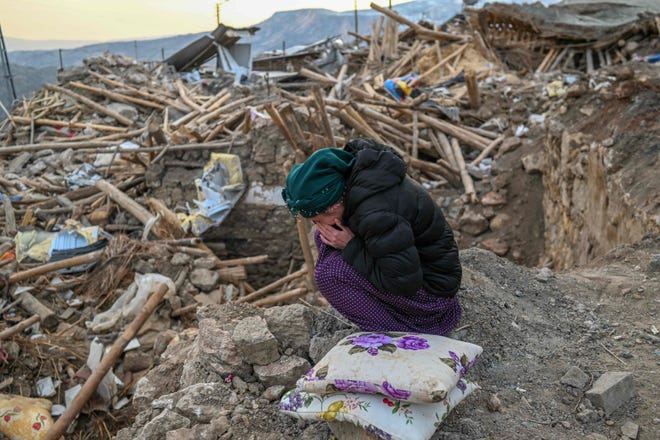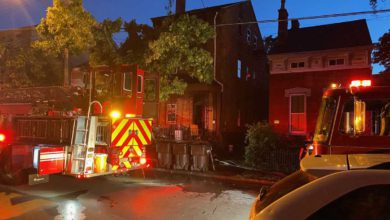
A 6.3 magnitude earthquake rocked Turkey’s Hatay province Monday, two weeks after the region was devastated by massive temblors and a series of strong aftershocks, injuring or trapping people inside already-damaged buildings.
Turkish Interior Minister Suleyman Soylu said three people were killed and 213 injured. An aid group with workers in Syria said people jumped from buildings in a panic.
"The new tremblor has unsettled families and communities who’ve already had their sense of security shaken to the core," Jenelle Eli, a global spokesperson for the International Federation of Red Cross and Red Crescent Societies, told USA TODAY from Geneva.
In Hatay, police rescued one person trapped inside a three-story building and were trying to reach three others inside, HaberTurk television reported. It said those trapped included movers helping people shift furniture and other belongings from the building that was damaged in the massive quake.
Syria’s state news agency, SANA, reported that at least six people were injured by falling debris in Aleppo and taken to the hospital.
The latest:
►Turkey’s state-run Anadolu Agency said the quake was felt in Syria, Jordan, Israel and Egypt.
►Buildings that survived until now may have been weakened and collapsed, trapping people who had sought shelter
►The U.S. has been providing assistance since the first round of quakes. Secretary of State Antony Blinken took a helicopter tour Sunday of some of the worst-affected areas and pledged a further $100 million in aid to help the region.
Panicked jump from buildings
In northwest Syria, aid workers with the nonprofit Union of Medical Care and Relief Organizations-USA reported at least 94 injuries and several collapsed structures, with a number of people hurt after jumping from buildings.
"Most of the injuries are a result of people panicking," said Najah Allouch, a spokesperson for the Minnesota-based group. "The latest information we have is that eight people jumped and were injured out of fear of their buildings collapsing. Luckily, they were only injured."
Deaths, injuries still being tallied
In the Turkish city of Adana, eyewitness Alejandro Malaver said people left homes for the streets, carrying blankets into their cars. Malaver said everyone is really scared and that “no one wants to get back into their houses.”
Turkish President Recep Tayyip Erdogan reportedly visited the region earlier Monday. Erdogan said around 1.6 million people are currently being housed in temporary shelters.
"We’re hearing reports of damage and loved ones separated and so the nightmare of the past few weeks is starting over again for some residents," Eli told USA TODAY.
Turkey’s disaster management agency, AFAD, said the quake was centered around the town of Defne in Hatay province. It was followed by a second tremor of magnitude 5.8. Reuters reported that Monday's temblor set off panic and damaged buildings in the city of Antakya.
Hatay province is on the Mediterranean coast, bordered by Syria to the south and east. The province was slammed by the Feb. 6 quakes that Turkish officials say killed more than 41,000 people in their country alone. Several thousand people also died in Syria as a result of the quakes, which injured tens of thousands of people across the two nations and left hundreds of thousands homeless.
US PROVIDES AID: Secretary of State Blinken toured Turkey’s earthquake zone, pledged $100M in aid

Disaster struck the region Feb. 6
On Feb. 6, a magnitude 7.8 quake struck southern Turkey, U.S. Geological Survey said. Hours later, a 7.5 magnitude quake hit more than 60 miles away. Scores of violent aftershocks followed, leaving destruction and devastation in their path.
RESCUES:Couple saved more than 12 days after Turkey, Syria earthquake, but children die
More than a week after the earthquakes, search teams said they were still hearing voices from under the rubble. Despite the rare, inspiring rescues, thousands of bodies were being removed from toppled buildings, and experts said the chances of finding survivors are increasingly slim. Two weeks later, many people remain in the streets without shelter.

Aftershocks collapse damaged buildings
Because so many people are seeking shelter in temperatures that are still dropping below freezing some nights, they appear willing to risk entering what appear to be undamaged buildings.
But those buildings may have been damaged by the initial quakes and were poised to collapse when this strong new aftershock occurred, California-based structural engineer Andy Thompson said.
"It's an extremely challenging situation made much worse by the continuous aftershocks and the concern of damaged buildings being pushed to the point of collapse," said Thompson, who has responded to quakes in Haiti, Chile and India. "You might have an undamaged home that's in the shadow of a building that's about to collapse."
Thompson, the CEO of quake-assessment company SafeHub, said quickly assessing the damage levels of buildings is a tough task, complicated by ongoing rescues, shortages of heavy equipment and safety concerns from aftershocks.
"In these situations, we would never say that a building is safe. The thing that structural engineers would be saying, what we're looking at, is the question: 'Is it less safe than it was before the primary event?'" he said. "The challenge is that you need to make thousands of evaluations very quickly with a limited number of experts."
Desperate survivors taking risks
Former U.S. Marine Andrew Cote, who recently returned from the Hatay area following a four-day search-and-rescue trip, said many buildings still standing were nevertheless teetering on the edge.
In one case, he said, two approximately six-story apartment buildings had teetered sideways into each other, posing significant risk of further collapse. In many other places, he said, the first floors of buildings collapsed but the rest of the building remained standing, sometimes with an exterior wall missing.
He said even without quakes, pieces of buildings were still falling off nearly two weeks after the initial quake. But with nowhere else to go, people are camping outside their former homes or sleeping in cars to stay warm in temperatures that are still falling below freezing some nights.
"My immediate thought is the few buildings that were still vertical have now come down, exponentially increasing the search area," he said Monday, reflecting on the new quake.
Cote works for BRINC Drones, which makes tactical drones with two-way video and audio capability. In Hatay, they used the drones to fly up several stories, break a window and then fly down hallways and through rooms to search, keeping rescuers outside until it was deemed safe or necessary to enter.
Cote said many international teams had sophisticated thermal cameras or acoustic sensors, but most of the searching is being done by hand by desperate residents searching for family members and friends.
"I saw people without shoes climbing around – it was so emotionally driven, with safety as an afterthought," he said. "They were in it with their hands, with fence posts that they turned into crowbars."
New damage worsens existing humanitarian disaster
Authorities are warning the disaster areas could be hit by a cholera epidemic, compounding the already dire risks facing displaced residents.
Many people are living in temporary shelters with poor access to hygiene, which raises concerns for the spread of infectious diseases. Syria was already facing a cholera outbreak, and a vaccination campaign to curb its spread was halted by the quake.
Additionally, millions are now living without permanent shelter or access to preventative medicine or treatment for ongoing disease like diabetes, because resources are focused on acute and disaster care.
"Restoring access to essential health and water services is crucial to prevent outbreaks and save lives," said Eli, the spokesperson for the Red Cross and Red Crescent Societies.
How to help Turkey, Syria:Relief efforts ongoing after more earthquakes rock region
Contributing: The Associated Press
Source link






